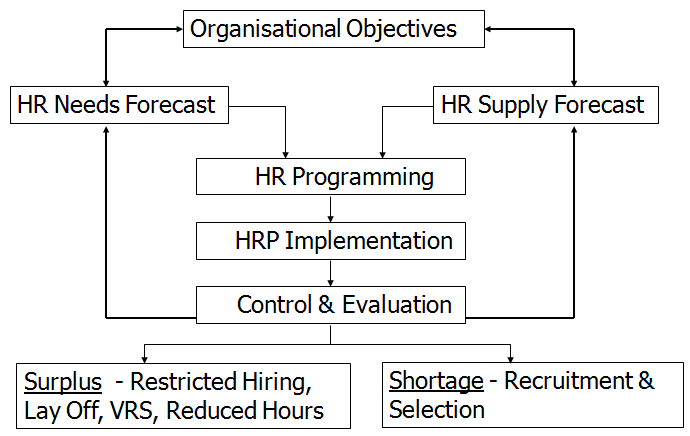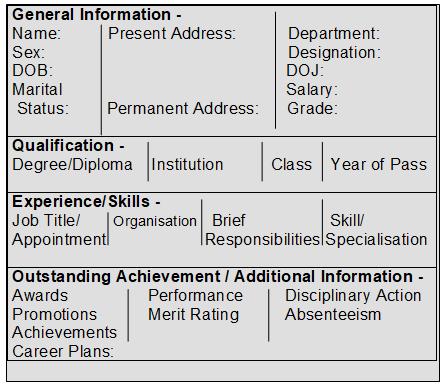What is Human Resource Planning (HRP) ?
According to Gessler, “Manpower planning is the process including forecasting, developing and controlling by which a firm ensures that it has
• The right number of people,
• The right kind of people,
• At the right places,
• At the right time, doing work for which they are economically most useful”.
Human resource planning is the process of anticipating and carrying out the movement of people into, within, and out of the organization.
Human resources planning is done to achieve the optimum use of human resources and to have the correct number and types of employees needed to meet organizational goals.
Salient features of HRP
1. It’s a systematic approach. because it ensures a continuous and proper staffing. It avoids or checks on occupational imbalances (shortage or surplus) occurring in any of the department of the organization.
2. There is a certain degree of flexibility. That is, it is subject to modifications according to needs of the organization or the changing circumstances.
3. Manpower plans can be done at micro or the macro levels depending upon various environmental factors.
HRP is a Continuous Process
- Forecasting future manpower requirements.
- Making an inventory of present manpower resources and assessing the extent to which these resources are employed optimally.
- Anticipating manpower problems by projecting present resources into the future
- Planning the necessary programmes of requirement, selection, training, development, utilization etc
Uses/ Importance of HRP
- Ensures optimum Utilization of human resources.
- Forecast future personnel requirements
- Match human resource related activities and future organization objectives efficiently.
- Achieve economies in hiring new workers.
- Coordination between various HR Programs such a employment equity plan and hiring needs
- Help determine recruitment/induction levels
- To anticipate redundancies/surpluses
- To determine training levels and works
- Know the cost of manpower if there is a new project is being taken up
Key Elements of HRP Process
Prof. Geisler outlined the responsibilities of Human Resource Department in respect of manpower planning thus:
• Assist and counsel operating managers to plan and set objectives.
• Collect and summaries manpower data keeping long-run objectives and broad organizational interests in mind.
• Monitor and measure performance against the plan and keep top management informed about it.
• Provide proper research base for effective manpower and organizational planning.
Thus, the three key elements of the process are
- Forecasting the demand for labor,
- Performing a supply analysis, and
— Balancing supply and demand considerations.
Human Resource Planning Process

Organizational Objectives & Policies
- HR plan should be based upon organizational objectives and policies. Specific requirements in terms of number and characteristics of employees should be derived from organizational objective.
While deriving HR plan from org objectives following pts should be taken into consideration.
- Downsizing / Expansion
- Acquisition / Merger / Sell-out
- Technology upgradation / Automation
- New Markets & New Products
- External Vs Internal hiring
- Training & Re-training
- Union Constraints
HR Demand Forecast
- HR demand forecast is process of estimating future quantity and quality of manpower required for an organization.
Demand forecast must consider following factors.
- External factors – competition, laws & regulation, economic climate, changes in technology and social factors
- Internal factors – budget constraints, production levels, new products & services, organisational structure & employee separations
FORECASTING TECHNIQUES
- Forecasting techniques vary from simple to sophisticated ones. Before describing each technique, it may be stated that organisation generally follow more than one technique.
The techniques are:
- 1. Managerial judgement
- 2. Ratio-trend analysis
- 3. Work study techniques
- 4. Delphi technique
- 5. Flow models
- 6. Others Quantitative method
Managerial Judgement
- In this, managers sit together, discuss and arrive at a figure, which would be the future demand for labour.
- The technique may involve a ‘bottom-up’ or a ‘top-down’ approach.
- In the first, ‘bottom-up’ line managers submit their departmental proposals to top managers who arrive at the company forecasts.
- In the ‘top-down’ approach, top managers prepare company and departmental forecasts.
- These forecasts are reviewed with departmental heads and agreed upon.
- Neither of these approaches is accurate – a combination of the two could yield positive results.
- In the ‘bottom-up’ and ‘top-down’ approaches, departmental heads are provided with
- broad guidelines.
- Armed with such guidelines, and a consultation with the HRP section in the HRM department, departmental managers can prepare forecasts for their respective departments. Simultaneously, top HR managers prepare company forecasts.
- A committee comprising departmental managers and HR managers will review the two sets of forecasts, arrive at a unanimity, which is then presented to top managers for their approval.
Ratio-trend Analysis
- This is the quickest forecasting technique.
- The technique involves studying past ratios, say, between the number of workers and sales in an organisation and forecasting future ratios, making some allowance for changes in the organisation or its methods.
- Demand forecast:- Production : inspectors
Work-study Technique
- Work-study techniques can be used when it is possible to apply work measurement to calculate the length of operations and the amount of labour required.
- The starting point in a manufacturing company is the production budget, prepared in terms of volumes of salable products for the company as a whole, or volumes of output for individual departments.
- The budgets of productive hours per unit of output are then multiplied by the planned volume of units to be produced to give the total number of planned hours for the period.
- This is then divided by the number of actual working hours for an individual operator to show the number of operators required.
- Allowance will have to be made for absenteeism and idle time.
Following is a highly simplified example of this procedure:

Delphi Technique
- The Delphi technique is a method of forecasting human resource needs. It is a decision Making tool.
- It is been used in estimating personnel needs from a group of experts, usually managers. The HR experts act as intermediaries, summarises the various responses and reports the findings back to experts.
- The experts survey again after they get this feedback. Summaries and surveys are repeated until the experts opinions begin to agree. This agreement reached is the forecasting of the human resource needs
Flow Models
- Flow models are very frequently associated with forecasting personnel needs. The simplest one is called the Markov model.
In this technique, the forecasters will
1. Determine the time that should be covered. Shorter lengths of time are generally accurate than longer ones. However, the time horizon depends on the length of the HR plan which, in turn, is determined by the strategic plan of the organisation.
2. Establish categories, also called states, to which employees can be assigned.
- These categories must not overlap and must take into account every possible category to which an indivdual can be assigned. The number of states can neither be too large nor too small.
3. Count annual movements (also called ‘flows’) among states for several time periods.
- These states are defined as absorbing (gains or losses to the company) or non-absorbing (change in position levels or employment status).
- Losses include death or disability, absences, resignations and retirements.
- Gains include hiring, rehiring, transfer and movement by position level.
4. Estimate the probability of transitions from one state to another based on past trends.
- Demands are a function of replacing those who make a transition.
HR Supply Forecast
HR Supply Forecast
- HR Supply forecast is process of estimating future quantity and quality of manpower available internally & externally to an organisation.
Reasons for supply forecast are:
(i) helps quantify number of people and positions expected to be available in future to help the organization realize its plans and meet its objectives;
(ii) helps clarify likely staff mixes that will exist in the future;
(iii) assess existing staffing levels in different parts of the organization;
(iv) prevents shortage of people where and when they are most needed, and
(v) monitors expected future compliance with legal requirements of job reservations.
Supply Analysis includes following consideration
- Existing Human Resources
- Internal Sources of Supply
- External Sources of Supply
(i)Existing Human Resources
- Capability / Skills Inventory using HR Information System
Human Resource Information System (HRIS)
- A human resource information system (HRIS) is a systematic procedure for collecting, storing maintaining, retrieving and validating needed by an organization about its human resources

(ii) Internal Supply:
- After analysis of existing Human resources planners can proceed with the analysis of internal supply.
The techniques generally used for Internal supply are:
- Inflows and outflows
- Turnover rate,
- Absenteeism,
- Productivity level,
- Movement among jobs.
Inflows and outflows:
The number of losses & gains of staff is estimated for specified period.

Turnover Rate
Turnover rate is the traditional and simple method of forecasting internal supply
Turnover Rate – refers to rate of employees leaving during specified period
Turnover Rate =(No. of separations in a year / Avg no. of employees during the year ) x 100
Absenteeism
- Absenteeism is understood as unauthorised absence from work.
- it amounts to absenteeism when an employee is scheduled to work but fails to report for duty
Absenteeism is calculated as:
Absenteeism= (Number of persons – days lost)/ (Average number of persons x number of working days )x 100
- If the absenteeism rate is four per cent, only 96 out of 100 people are available for work.
Productivity Level
- Any change in productivity would affect the number of persons required per unit of output
- Increase in productivity will reduce the requirement, and decrease in it would have the opposite-effect
Movement among Jobs
- Some jobs are sources of personnel for other jobs.
For example, secretaries may be obtained by the promotion of typists, and branch managers are obtained from a pool of section managers
(iii) External Supply
- In addition to internal supply, the organisation needs to look out for prospective employees from external Sources.
External sources are important for specific reasons:
(i) new blood and new experience will be available,
(ii) organisation needs to replenish lost personnel
(iii) organisational growth and diversification create the needs to use external sources to obtain additional number and type of employees.
Sources of external supply
Sources of external supply vary from industry to industry, organisation to organization, and also from one geographical location to another.
Organizations find their best source of further employees are :
- Colleges and universities
- Consultants
- Competitors
- Unsolicited Application
HR Programming
- Once an organisation’s personnel demand and supply are forecast, the two must be reconciled or balanced in order that vacancies can be filled by the right employees at the right time.
HR Plan Implementation
- Implementation requires converting an HR plan into action.
- A series of action programmes are initiated as a part of HR plan implementation.
- Some such programmes are recruitment, selection and placement; training and development; retraining and redeployment; the retention plan and the succession plan

Control and Evaluation
Control and Evaluation
- Control and evaluation represents the fifth and the final phase in the HRP process
- The HR plan should include budgets, targets and standards.
- It should also clarify responsibilities for implementation and control, and establish reporting procedures which will enable achievements to be monitored against the plan.
- These may simply report on the numbers employed against establishment (identifying both those who are in post and those who are in pipe line) and on the numbers recruited against the recruitment targets.
- It should also report employment costs against budget, and trends in wastage and employment ratios.
